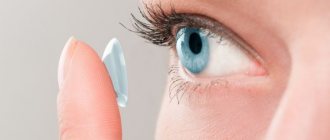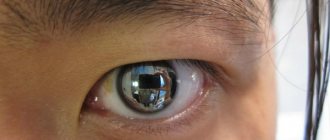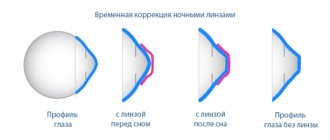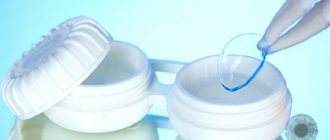Anyone who decides to give up glasses in favor of contact lenses finds it difficult to cope with them the first time. Instructions on how to put on lenses make the task much easier. Everything else is a matter of practice. In a few weeks the person will practice this action until it becomes automatic.
- 4.1 How to determine the correct position
- 6.1 Additional recommendations
Types of contact lenses
Instructions on how to properly put on lenses do not depend on their type. The main classification is based on the refractive error they are intended to correct. There are models that help restore clarity of vision with:
- Myopia. The greater the distance between the object and the eyes, the more it “blurs.” Spherical contact lenses are used for correction.
- Presbyopia. This is “age-related farsightedness.” The symptoms are the same as for hypermetropia. To restore vision, you need multifocal lenses.
- Hyperopia. What is nearby appears blurry to a person. For example, difficulties arise with reading. Spherical contact lenses are also required.
- Keratoconus. A pathology in which the cornea becomes thinner, simultaneously changing its shape from spherical to cone-shaped. For correction, scleral lenses are worn, which differ from ordinary ones in their larger diameter.
- Astigmatism. Clarity of vision suffers due to changes in the shape of the lens. For correction, toric lenses are worn.
Color contact lenses
Sometimes contact lenses are worn by people who do not need vision correction. “Image” models are represented by several groups:
- Tinted. They are worn to highlight the natural color of the eyes and make it more saturated. The look becomes more expressive and impressive.
- Colored. They differ from tints by using a brighter pigment. They give an unnatural color, such as emerald.
- "Creative" or "fantasy". They allow you to change the shape of the pupil from round to elongated (“cat” or “snake”), get a color of the iris that is not found in nature, or turn the eye into an “art object” (billiard ball, soccer ball).
Tint and color models are available with and without diopters.
Tinted varieties are not included in the “colored” category. They appear transparent to the eyes. Manufacturers give them a pale greenish or bluish tint for ease of handling.
The dye is not applied to the outer surface of the lens, so it cannot come into contact with the cornea. The central part covering the pupil is never painted. Therefore, wearing such correction means does not affect the sharpness, clarity of vision, or color perception.
Colored contact lenses are also used for medical reasons. They are worn for various iris defects, congenital or acquired. These include:
- heterochromia (different eye colors or “spots” of a different shade on the iris);
- coloboma (“splitting” of the iris into separate “fragments”);
- leukoma (cloudness, “sore” on the eye);
- albinism (almost colorless pale gray or watery blue, pinkish or reddish iris).
Ophthalmologists also recommend them for people with increased photosensitivity (they play the role of sunglasses, protecting the eyes from ultraviolet rays).
Classification by period of wearing
Another important parameter is the wearing period. The nuances of care depend on this. Models are:
- Disposable. They are put on in the morning and taken off in the evening and thrown away immediately. You can't sleep in them.
- Flexible wearing mode. They are worn without taking them off for 2-3 days. Less often, the wearing period is 5-6 days.
- Planned replacement. They need to be put on and taken off daily and are not intended for sleeping. The service life of one pair is from 1-2 weeks to six months (rarely up to a year).
- Long wearing. Do not remove for 2 weeks, a month or 3 months.
- Orthokeratological. Worn only while sleeping, they are intended to correct vision at night. During the day, thanks to them, a person does without corrective glasses.
It is more convenient to purchase disposable correction products in whole packages.
Classification by material of manufacture
The material from which contact optics are made can cause allergies. Therefore, manufacturers use several varieties of it. Lenses are:
- Tough. They are divided into gas-permeable and gas-tight. The material used is silicone based. They do not deform even when worn for a long time, do not move when blinking, and the surface does not scratch.
- Soft. There are hydrogel ones (they have a short period of use, but at the same time they are very thin, smooth, and maximally saturated with moisture), and silicone hydrogel ones (they combine strength and resistance to mechanical damage with good oxygen permeability, providing the cornea with the necessary hydration).
There are no models designed specifically for beginners that would be easier to take on and off.
What contact lenses are prescribed for beginners?
Ophthalmologists quite often recommend that their patients purchase Acuvue Oasys with Hydraclear Plus lenses. The optical products of this brand have proven themselves well and are in high demand among customers. This model of contact lenses will help correct your vision within two weeks. It is made from Senofilkon A, which is particularly soft, making Acuvue Oasys with Hydraclear Plus ideal for new and inexperienced users. Such means of contact correction do not require adaptation and guarantee wearing comfort.
Another high-quality lens is Dailies Total 1, which is considered a revolutionary discovery in the field of contactology. Manufactured on the basis of the unique water-gradient material Delefilcon A, they are characterized by a high level of moisture content.
When creating the products, a patented technology was used to effectively retain moisture and thereby nourish the cornea.
This eliminates the occurrence of dryness and burning in the eyes. Given the high performance characteristics of contact lenses, ophthalmologists regularly recommend them to new users.
For those who start using contact lenses, ophthalmologists advise choosing models developed using HydraGlyde technology. These are Air Optix plus HydraGlyde lenses, which have a unique matrix built into the inner layer of optical products. This provides incredible wearing comfort and eliminates dehydration. As a result, your eyes will be reliably protected from redness, dryness and fatigue. In addition, when creating contact lenses, SmartShield plasma surface treatment technology was used, which guarantees high wettability.
How to prepare to wear
To quickly learn how to put on and remove lenses, you need to take into account the recommendations of ophthalmologists:
- Do not be afraid. Lenses selected taking into account all parameters are safe for vision. Most models do not require getting used to wearing, are not felt, do not cause the feeling of “sand” or “glass”, “foreign body” in the eyes. They don't hurt to put on or take off.
- Stock up on time. In the first few days the procedure is delayed. Not everyone can manage with 5-10 minutes. For beginners, it is important to put on and remove lenses without haste.
- Watch some training videos. They are posted on the official websites of many manufacturers. For the first time, a person will put on and remove lenses under the supervision of an ophthalmologist, who will describe the process in detail. But many people perceive a visual demonstration better than verbal explanations.
- Get used to it gradually. You shouldn’t suddenly give up corrective glasses. During the first week, it is recommended to wear contact lenses for a maximum of 3-6 hours per day.
You cannot put on or remove contact optics without preparing everything you need:
- soap and hand towel;
- cleaning solution;
- storage container;
- tweezers with “pads” made of soft rubber or silicone.
Why shouldn't you choose contact lenses yourself?
We have already said that it is impossible to choose contact lenses without knowing the radius of curvature of the eyeball, therefore, you first need to see a doctor to get a prescription. Only a specialist can assess whether the lenses are chosen correctly by assessing their position in the eye and “measuring” vision. The doctor will be able to quickly and efficiently select lenses that will suit you and correctly correct your vision.
The first experience of putting on contact lenses can be difficult, because the eye does not immediately accept a foreign body, so the doctor will show and tell you how to do it correctly so as not to experience difficulties. And when the lens selection is completed, he will provide you with information on how to care for the lenses and how often they need to be replaced.
Do not forget! It is necessary to visit an ophthalmologist at least once a year!
Lens selection
Selection of contact lenses is the task of an ophthalmologist. An unsuitable model can aggravate existing vision problems and cause severe discomfort when wearing.
Therefore, you should not purchase vision correction products based on the advice of non-professionals or based on the appropriate price. Signs of a wrong choice:
- blurred, blurred vision;
- pain in the eyes (from mild tingling to severe pain);
- redness of the whites of the eyes;
- uncontrolled lacrimation, increased photosensitivity;
- attacks of headache or persistent migraine.
When selecting lenses, the ophthalmologist takes into account:
- Diagnosis of a person. The first thing the doctor checks is the visual acuity of each eye separately (it can vary significantly). Then the reason for its deterioration is determined.
- Curvature of the cornea. Determined using autorefractometry. If there is no tight fit, putting it on may be difficult. It is easy to lose lenses by turning your head suddenly. When the model “sits down” too tightly, the eyes are forced to strain a lot. This provokes problems with blood vessels and corneal hypoxia.
- Diameter, thickness of the cornea (often causes increased sensitivity). In this case, it is recommended to wear only varieties with UV protection.
- Conditions of wearing. If you are often in rooms with low air humidity, you need a model that is as saturated with moisture as possible to avoid “dry eye” syndrome.
- A person’s lifestyle, his wishes regarding the timing of continuous wearing and replacement.
An obligatory step when choosing contact lenses is trying them on. Many salons offer not only to practice putting on the correction product, but also to walk around in it for several hours or even a day in order to exclude an allergic reaction to the chosen pair.
In the vast majority of cases, the ophthalmologist will recommend purchasing lenses from a well-known brand. This is a guarantee of high quality. Such companies use the most modern materials and technologies.
Wearing rules
Contact lenses can be worn throughout your life, or you can use them 2 times a week to create an exotic look. The wearing mode and service life depend on the nature of the disease, the purpose of the device, the material and color of the product. Find out how to put on colored lenses for the first time here.
How to start wearing:
- The procedure is performed after thorough hand washing.
- Before putting on, the lens is inspected; if there are defects or cracks, do not use it.
- In ready working condition, the edges of the lens are directed upward, in the form of a bowl. If this is not the case, it needs to be turned out.
- The product is picked up on the tip of the middle finger. Using the fingers of the other hand, the upper and lower eyelids are pulled back and the optical device is inserted just below the edge of the iris.
- There is no need to press the product, since it sticks on its own due to the surface tension of the liquid.
- To check the correct position, you need to lower your eyelids and move your eyes from side to side. It shouldn't be felt.
How much to wear
How long lenses last for vision depends on their purpose and material. First of all, products are divided according to their service life:
- Daily – designed to be worn throughout the day. It cannot be used a second time. They are not cleaned or stored, but are removed and thrown away before going to bed. This is the safest option, but also expensive. Find out whether you can sleep during the day wearing daily lenses here.
- Planned wearing – they are oxygen permeable and suitable for wearing day and night. Depending on the structure and character, you can wear them from 1 week to 3 months.
- Hard ones can be worn for more than six months. They are stronger, but have less oxygen permeability. At night they must be removed, cleaned and stored in a special solution. This is a budget option, but it is also considered dangerous - there is a risk of damaging the cornea.
Contact lenses are also distinguished by the method of wearing, that is, by the duration of the period of continuous wear:
- daytime – designed for use throughout the day;
- flexible – continuous wearing is allowed for 2–3 days;
- prolonged action - the patient can wear it for 7 days without removing it at night;
- constant wearing - it is allowed to carry it without taking it off for up to 30 days in a row. Such lenses are made of material with high gas and moisture permeability, which determines their cost.
If the cornea is highly sensitive and prone to conjunctivitis, permanent lenses are not used.
Who can't wear
There are a number of contraindications in which vision correction with a lens, as well as the use of decorative products, is prohibited:
- allergy to the material of manufacture or to a component of the solution;
- for inflammatory diseases: such as conjunctivitis or blepharitis;
- drooping of the upper eyelid precludes the use of this remedy;
- diseases – AIDS, tuberculosis;
- with high dryness of the cornea or increased tearing.
With colds, the mucous membrane of the eye also dries out, so in case of acute respiratory viral infections, severe colds, flu, wearing films is temporarily avoided.
Complications with first or constant wearing
Most often, complications when wearing lenses arise due to the wrong choice of product or prolonged wear. The consequences of wearing can be as follows:
- Corneal edema – occurs due to insufficient oxygen supply.
- Protein deposits – protein, calcium, and fat accumulate on the surface of the lens. Over time, this leads to inflammation.
- Allergy , especially delayed, to the material or ingredient of the solution, leads to the development of conjunctivitis.
- Lack of oxygen that occurs when wearing SCLs causes overgrowth of blood vessels in the cornea. This negatively affects vision.
- Microbial keratitis - occurs when Pseudomonas aeruginosa, staphylococcus and other pathogenic microflora enter and multiply.
If you experience a burning sensation in the eyes, a decrease in vision clarity, or photophobia, you should immediately discard the lenses.
At what vision level can you start wearing lenses? Can you wear them for the rest of your life?
How long you can wear lenses depends to a large extent on individual characteristics. Some people can use devices all their lives, while others are forced to give them up after 5-6 years and correct their vision with glasses.
What type of vision do you start wearing films for? Therapeutic and corrective models are prescribed for any deviations - myopia, amblyopia, aphakia and astigmatism. The degree of deviation is unimportant, but with a small vision defect they can not be worn all day, but only for a few working hours. The best moisturizing drops for wearing lenses are collected in the article.
How long it takes for the eyes to get used to the lenses depends on the individual characteristics of the patient.
Can it be worn on one eye if the other is healthy?
This is only allowed in 2 cases:
- a decorative film is used that does not affect vision in any way;
- A treatment lens is installed for monocular correction.
In all other cases, “one-sided” correction is prohibited. The brain in this case processes 2 different images that do not compensate each other. After just 2 days, severe visual disturbances begin and a headache appears. The pros and cons of lenses are described in the link.
After lens surgery
Whether and which lenses can be worn after surgery depends on the nature of the procedure and the severity of the defect. On average, it is recommended to avoid wearing ophthalmic products for 2 weeks until the tissue has healed completely. It may take a long time.
After keratoplasty, corrective products are not recommended to be worn. Most likely, it will have to be made to special order, since the shape of the cornea after the operation becomes specific.
After lens replacement, lenses cannot be worn. If necessary, you can correct your vision with glasses.
For strabismus, glaucoma
A special type of soft contact lens is used to treat squint in one or both eyes. The devices reduce the divergence of the eye muscles, which allows you to correct vision and gradually reduce the defect.
The impact is provided by 2 mechanisms:
- Lenses of different effectiveness are installed on the eyes in order to increase the activity of one eye and reduce it in the other;
- use models with a partially shaded pupillary area.
Contact lenses do not affect intraocular pressure in any way, so they can be worn for glaucoma.
Allergies as a consequence of incorrect wearing
The film material or components of the solution in which they are stored may cause allergies. The exact cause of irritation can be determined after examination. If this is the case, select a different type of product and a solution of a different composition - their choice is extensive.
If symptoms appear - burning, stinging in the eyes, redness, you should also pay attention to eye drops.
If you have seasonal allergies, it is not recommended to wear contact lenses, since at this time immunity decreases and the mucous membrane of the eye dries out faster.
Why does my head hurt when wearing it: how much to wear, when to take it off
4 causes of headaches when using correction products:
- incorrect selection of diopters, due to which the eye muscles tense unproductively;
- incorrect choice of films - small or large diameter, hard material, also causes discomfort;
- inflammation of the paranasal sinuses due to allergies causes headaches and eye pain;
- drying of the mucous membrane leads to irritation, pain in the eyes and photophobia. Symptoms include headache.
How to use - step-by-step instructions on how to easily insert and remove
It is more convenient for beginners to put on lenses while sitting, with their elbows on the table in front of a mirror standing at an angle. Once you have acquired the skills, you can do this while standing. Correct algorithm of actions:
- Wash and dry your hands. It is recommended to purchase soap with antibacterial properties, without dyes and perfumes. You need to dry your hands with a lint-free towel (waffle, not terry). Fibers remaining on the fingers can get under the lens, causing discomfort. If there is nowhere to wash your hands, you can treat them with an antiseptic.
- Using tweezers (or your fingers, not your nails), remove the contact lens from the container. Place the pad of the index finger of the “leading” hand in the middle. Women who have not yet learned to put on the correction device “automatically” are advised to temporarily abandon long nails in order to avoid accidental injuries to the cornea.
- Bring the lens to the light source and make sure that it is not inside out, there are no scratches, dust particles, or tears at the edges. Press the fingers of your free hand, spread in the letter V, to the eye from the outer corner and pull the eyelids down and up, opening it as wide as possible.
- Looking up, gently press the lens onto the cornea so that it aligns with the iris. It is important that the hand spreading the eyelids does not tremble, and the eye itself does not twitch when changing the direction of gaze. Significant difficulties for those who put on lenses, just starting to get used to them, are caused by uncontrolled blinking.
- Gently release the eyelids. When done correctly, the lens remains on the cornea. To center it correctly, you need to blink a couple of times.
- Repeat the same with the other eye.
It is recommended to constantly put the lens on first the right eye and then the left eye (or vice versa) and remove them in the same way, placing them in the appropriate cell of the container (they are marked “R” and “L”, often differing in color).
This eliminates the risk of infection spreading from one eye to the other. It is important to follow this rule for people whose visual acuity is different. This makes it impossible to confuse lenses with different optical powers.
How to determine the correct position
If you put the lens on inside out, the image will be blurry. If worn incorrectly for a long time, discomfort, irritation, pain and pain in the eyes occur. If such an error becomes regular, gradual deformation of the cornea is possible, which provokes a further deterioration in the quality of vision.
Each side of the optics surface has its own function: the inner side is “responsible” for the correct “fit” on the cornea, the outer side is for correcting clarity and sharpness. Many (several numbers or letters). If the lens is turned inside out, they are read as a mirror image. It is easier for a beginner to put on such models; the possibility of error is eliminated.
In the absence of such an indicator, you need to focus on the shape of the lens. In an inverted state, it resembles a plate with characteristic sides; in the correct state, it is smoother, cup-shaped, like a segment of a sphere.
Another effective method of checking the correct position is to try to bring the edges together. In the inverted position, it will not be possible to do this without first “gluing” the lens almost in half. In the desired form, the edges “converge” first.
How to remove lenses
Removing contact optics is no more difficult than putting it on; many steps are repeated:
- Wash and dry your hands thoroughly.
- Look up and pull down the lower eyelid with your middle and ring fingers.
- Using your index finger, carefully “pull” the lens downwards or towards the inner corner of the eye, “unsticking” it so that it no longer adheres completely to the cornea.
- “Pinch” the resulting fold, removing it from the eye.
- When removing the lens, you must act carefully so as not to damage it. Place models of “repeated” wearing with tweezers into the desired compartment of the container. Disposable - throw away.
When the lens you just put on “feels” in your eye, there is no need to remove it and put it back on. This is normal. There is also no need to remove it when the alignment is “off” (for example, if a person accidentally rubs his eyes with his hand). You need to cover your eye, but without squinting, with the pad of your finger and light “massaging” movements to restore the centering and correct position.
Do your eyes hurt after wearing lenses? We described how to avoid unpleasant consequences in our separate article.
How to put on lenses correctly
Only a correctly positioned lens, without defects, can be worn, and the main rule is to be careful. If you are going to wear it for the first time, you should sit in front of a mirror at a table, in case you accidentally drop the product from your hands. Having placed it on the index finger of the hand, with the thumb or middle finger of the same hand you need to push back the lower eyelid, and with the fingers of the other hand you need to push back the upper eyelid.
Looking straight ahead or lifting your eyes up (whichever is more convenient for you), place the lens just below the pupil line, after which you can slowly release your eyelids. Reflexively, when the eyelids close, the gaze drops down. In order for the lens to finally take its correct position, you can massage your eyes through a closed eyelid or blink your eyes. The second device should be put on according to the same principle.
If your attempt is unsuccessful, or if you drop the lens, you need to rinse it in a special solution and only then put it on.
Is it painful to put it on for the first time and the problem of “reflexes”
If you wear vision correction products following the recommendations of ophthalmologists, you will not experience any pain. But for beginners who have not yet brought the skill to automaticity, it is easier to accidentally injure themselves. For example, damaging the cornea or mucous membrane with a long nail. Therefore, it is important to wash your hands thoroughly every time to avoid infection.
Since the first attempts take up to a quarter of an hour, when the lens takes the required position, there may be a feeling of a “foreign object” in the eye, a slight tingling sensation, itching. This is not a reason to visit an ophthalmologist. But if there is a persistent burning sensation, pain, a feeling of “broken glass” in the eyes, or uncontrollable lacrimation, a consultation is required.
The desire to blink involuntarily when a foreign object approaches the eyeball is completely natural. To cope with the problem of reflexes, you will have to learn to hold the upper and lower eyelids simultaneously with a “steady hand”, opening the eye as wide as possible and not allowing it to close.
What should new contact lens users pay attention to?
As a rule, having learned that there is a flexible and prolonged mode of wearing contact lenses, many beginners want to purchase just such optical products. However, ophthalmologists strongly recommend that new users wear daily lenses. With this, optical products need to be put on every morning, and before going to bed, take them off and place them in a special solution for disinfection. This will allow the eyes to rest and eliminate such unpleasant symptoms as itching, burning and redness of the cornea.
New contact lens users pay insufficient attention to the radius of curvature, believing that the main selection parameter is optical power. However, this opinion is erroneous, because if this value did not play a significant role, then ophthalmologists would hardly have spent time determining it.
The fact is that comfortable wearing can be guaranteed only if the radii of curvature of the cornea and the optical product coincide.
This determines how tightly the lenses will fit to the eyeball. This indicator is individual, and therefore you need to purchase contact lenses only with a prescription.
Proper care
Only disposable vision correction products require no maintenance. The recommendations of ophthalmologists must be strictly followed:
- Be sure to wash removed lenses. Place them on the pad of your index finger and drip 2-3 drops of solution inside. Then the index finger and thumb are folded together and gently wipe both surfaces. After adding a little more solution, the optics are “rinsed”.
- Rinse the container before putting lenses inside. You cannot mix old and fresh liquid in it. It is rinsed with a disinfectant solution and wiped dry with a paper napkin or allowed to dry naturally.
- Place the removed lenses each in its own compartment of the container, filled with fresh disinfectant solution. The processing time is not indicated anywhere, but the longer a person does not remove the lenses, the longer they should remain in the antiseptic solution. Minimum period 3-5 hours.
- Use enzyme tablets weekly for deeper cleansing. The container is filled with a solution and a tablet is placed in each compartment. Models for long-term and extended wear are kept in the solution for 6-8 hours, for daytime wear - a maximum of half an hour. Then they need to be washed again with the solution. Fresh liquid is poured into the container and left for 3-4 hours.
- Women who use decorative cosmetics should put on contact lenses before applying makeup and remove them before washing. Otherwise, particles of cosmetics may get on the surface of the optics and under it.
- You should not sleep in lenses that are not intended for sleep, even for a short time. This can cause severe itching, burning, and redness of the eyes.
- From time to time your eyes need rest. Especially if long-term wearing models are used. Before putting on a new pair, allow your eyes to rest for at least a day.
- Monitor service life. Do not exceed the wearing period specified by the manufacturer; use the solution if a certain time has passed after opening the container. To remember this, you can write the corresponding dates on the packages.
Selecting wearing mode and replacement frequency
The period and terms of use of contact lenses are determined by the doctor in accordance with the characteristics of the patient. When prescribing all CLs for the first time, except for night ones, a schedule is introduced that ensures the eyes gradually get used to the optical system:
- day 1 – use no more than 2 hours, but not less than 30 minutes;
- day 2 – can be used for 2-3 hours;
- day 3 – put on for 4 hours, and each subsequent day up to 7, the wearing period increases by 1 hour;
- Day 8 – full use is allowed in accordance with the recommendations of a specialist.
Wearing night-time contact lenses is determined by the length of night's rest. But, if a person using night CLs sleeps less than 6 hours, then the optics should not be removed immediately after waking up, since the full therapeutic effect will not occur. Also, do not leave lenses on your eyes for more than 8 hours.
Extended wear or flexible wear optics are indicated only as prescribed by the attending physician. But, under any circumstances, the period cannot exceed 7 days in a row, as this will negatively affect eye health. There are long-wear models on sale, the period of continuous use of which is stated to be 30 days. However, ophthalmologists urge patients to refrain from such decisions.
The frequency of replacement is also determined by the doctor, but at the patient’s request, lenses with more convenient replacement can be selected. It should be noted here that there will be no special financial savings from the use of contact optics for a planned replacement, in comparison with a one-day replacement. The apparent difference in price is fully compensated by:
- ease of use of “daily bags” - they do not require any care at all;
- cost of solutions - antiseptic and moisturizing solutions are not needed for daily optics;
- at the cost of optics during emergency replacement - if the planned replacement cable is damaged, it will have to be replaced earlier.











